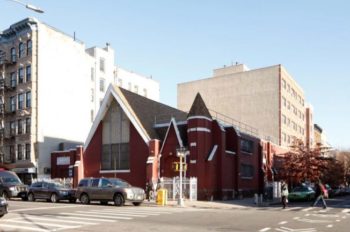
The 1st Spanish Methodist Church was removed from the Landmarks calendar. Image Credit: NYC Landmarks Preservation Commission
Church removed from Landmarks calendar after complex history divides community members. On December 11, 2018, the Landmarks Preservation Commission held a discussion about the 1st Spanish United Methodist Church located at 163 East 111th Street and Lexington Avenue in East Harlem. The Church was constructed in 1880 for the Lexington Avenue Baptist Church but was rebuilt in the mid-1960s after a fire destroyed most of the first floor. The Church was calendared in December 2017.
The Church was first discussed for calendaring in 2017, when the Church, along with Public School 109 (El Barrio’s Artspace P.S. 109), the Richard Webber Harlem Packing House, and Benjamin Franklin High School (Manhattan Center for Science and Mathematics) were all flagged for consideration in preparation for the East Harlem Rezoning Proposal approved by City Council in November 2017. The other three buildings were all designated in early 2018.
Landmarks calendared the Church for consideration on December 12, 2017, due to its cultural significance to the Puerto Rican community and historical significance. However, Landmarks did not take any action in the designation process since the calendaring in December 2017.
In 2016, City Council amended the Landmarks law to require that within twelve months of calendaring, the Commission has to designate the landmark, enter into an extension with the consent of the owner, or removed the item from the Commission’s calendar. If no action is taken by Landmarks, the item will be automatically removed once the twelve-month period expires. Landmarks held the discussion on December 11, 2018, to address the status of the Church before the twelve-month period expired.
The Church’s complicated history delayed the designation process. Community members were divided about using landmark designation to recognize the historical significance of the church because of the building’s association with the Young Lords, a civil rights activist group.
The Young Lords were a Puerto Rican civil rights activist group that formed out of Chicago and were modeled after the Black Panther Party during the 1960s. The New York chapter was created in 1969 to fight for better living conditions and treatment for over 800,000 Puerto Ricans in New York City. One of the chapter’s first successful protests involved blocking major avenues in Manhattan with piles of uncollected garbage to demonstrate New York City’s failure to keep East Harlem clean.
The 1st Spanish United Methodist Church became associated with the Young Lords after the group took over the Church on multiple occasions. In winter of 1969, the Young Lords occupied the Church and for eleven days used the space to provide community services like basic health tests, lessons on Puerto Rican history, and breakfast and daycare programs for children. The Young Lords again occupied the Church in late 1970 to protest the conditions of New York City jails. The 1970 occupation lasted for over 50 days.
Many community members who were present for these occupations, however, did not remember the Young Lords for their fight for justice. According to Landmarks research staff, some of the current congregation members who were present for the 1970 occupation told Landmarks staff that they remembered the occupation as a “painful terrorist incident of which they have never fully recovered,” stating that the Church had just reopened after the devastating 1964 fire only to be taken away again by “men with military uniforms and guns.”
According to Landmarks staff, Council Member Diana Ayala and community members wanted more time to continue discussions about the Church. Council Member Ayala was concerned about dividing the community with this designation. Landmarks staff recommended not holding a public hearing or vote at this time. Acknowledging the sensitivity of the matter and allowing more time for community discussions, Chair Sarah Carroll called for no action. The Church was removed from the calendar on December 12, 2018, when the twelve-month period allowed by law expired. The church can still be considered for designation in the future.
By: Veronica Rose (Veronica is the CityLaw Fellow and a New York Law School Graduate, Class of 2018.)

